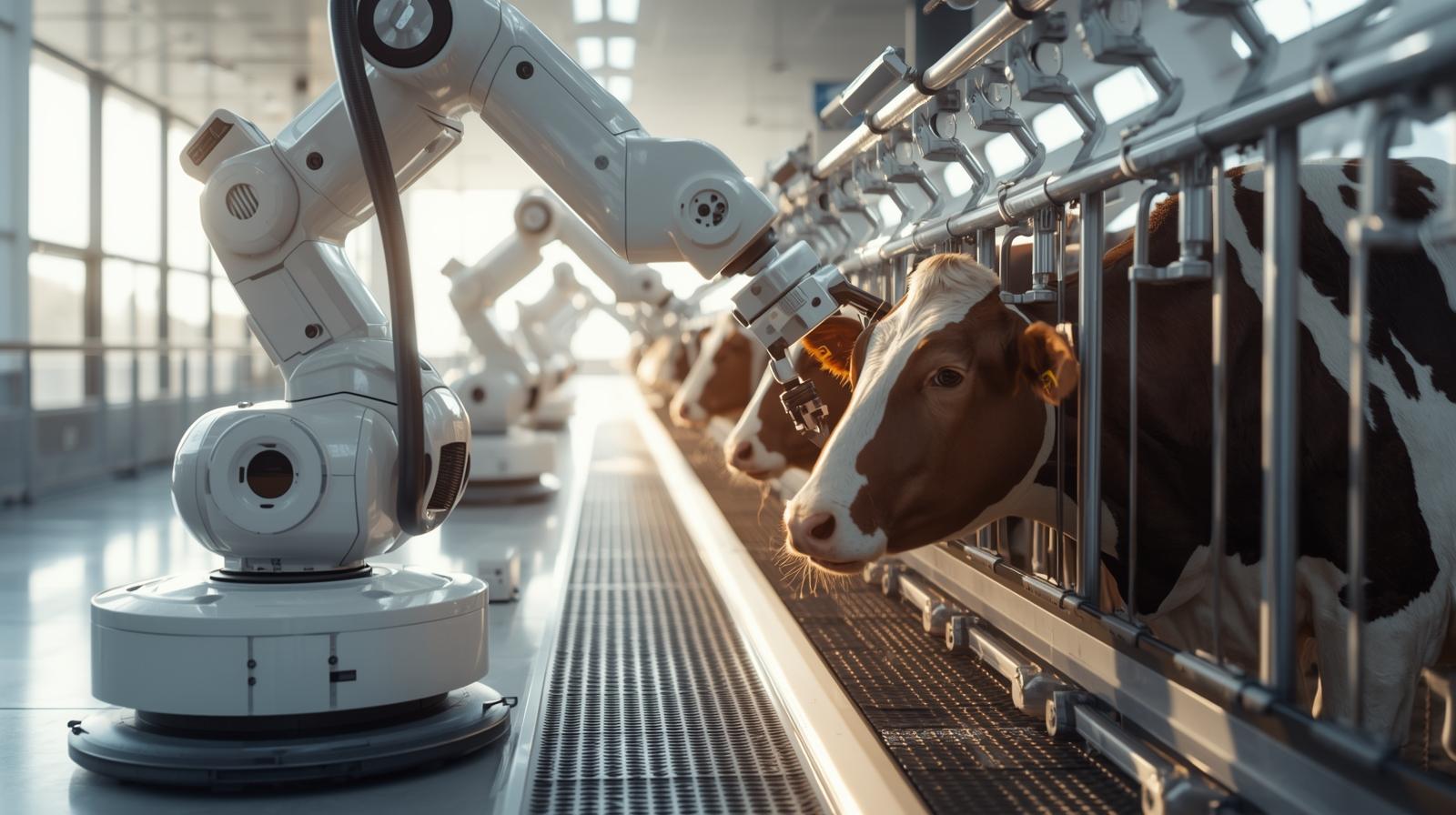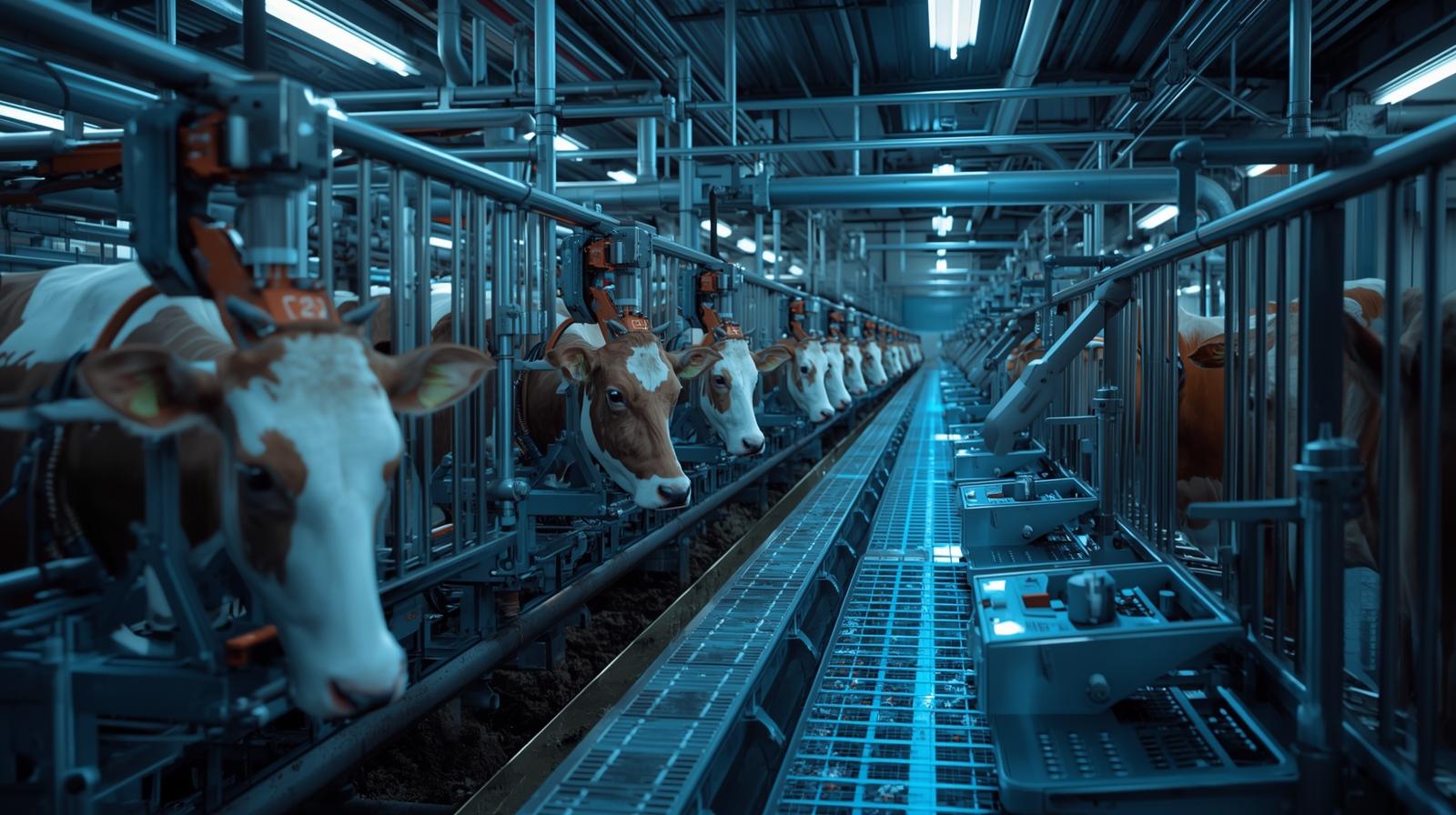The agricultural sector is undergoing a profound technological revolution known as smart farming. This approach integrates advanced technologies into traditional practices to enhance efficiency and productivity. One of the most mature and impactful applications of smart farming is found in the dairy industry. Milking automation represents a cornerstone of this modern agricultural transformation. It moves dairy farming beyond manual labor into a data driven and automated operational model. This shift is not merely about replacing human effort but about fundamentally improving herd management. The global milking automation market is experiencing significant growth as farmers recognize its immense value. This article will explore the vast opportunities within this dynamic and evolving market.

Defining Milking Automation Systems
Milking automation refers to the use of robotic and automated systems to milk dairy cattle without human intervention. These systems are sophisticated pieces of engineering that combine robotics, sensors, and data analytics. A typical automated milking system, or AMS, allows cows to choose their own milking schedule. This voluntary milking concept is a key feature of modern barns. The system identifies the cow, cleans her teats, attaches the milking cups, and monitors milk quality. After milking is complete, the cups detach automatically and the data is recorded. This entire process operates around the clock, providing unparalleled flexibility for both the farmer and the herd.
Current Market Landscape and Growth Drivers
The global milking automation market is on a strong upward trajectory, fueled by several powerful factors. A primary driver is the increasing global demand for dairy products, which pressures farmers to enhance production efficiency. Concurrently, a persistent labor shortage in the agricultural sector makes automation an attractive solution. Farmers are increasingly seeking technologies that reduce dependency on manual labor. Government initiatives and subsidies in many regions are also promoting the adoption of smart farming technologies. Furthermore, the rising awareness of animal welfare is pushing for less stressful milking practices. These combined forces create a fertile ground for the expansion of milking automation systems worldwide. The market is responding with innovative products and solutions to meet this growing demand.
The milking automation industry is projected to reach USD 3.68 billion by 2030 from USD 2.61 billion in 2025, at a CAGR of 7.1% from 2025 to 2030.
Download PDF Brochure @ https://www.marketsandmarkets.com/pdfdownloadNew.asp?id=265039621
Key Technological Innovations in Automation
Technological advancement is the engine of the milking automation market. Modern systems are equipped with an array of sophisticated sensors and data analytics capabilities. These sensors monitor milk yield, quality parameters like fat and protein content, and even the cow’s activity levels. Robotics have become incredibly precise, ensuring gentle and efficient attachment of milking units. Integration with the Internet of Things, or IoT, allows these systems to become part of a connected farm ecosystem. Data from the milking robot is fed into central farm management software. This integration provides a holistic view of each animal’s health and productivity. Artificial intelligence is now being used to predict health issues like mastitis before clinical signs appear.
Primary Opportunities for Market Growth
The milking automation market presents a multitude of growth opportunities for manufacturers and service providers. One significant opportunity lies in the small to medium sized farm segment, which is increasingly adopting compact and affordable systems. Emerging economies with growing dairy sectors represent a vast untapped market for basic and cost effective automation solutions. There is also a growing demand for integrated systems that combine milking data with other farm management data. Service based models, such as Robotics as a Service, or RaaS, can lower the entry barrier for many farmers. Furthermore, continuous software upgrades and predictive maintenance services offer recurring revenue streams for companies. The development of systems for other dairy animals like goats and buffaloes opens new market niches.
Enhancing Herd Health and Productivity
Automated milking systems deliver substantial benefits in herd health and overall productivity. The constant monitoring of each cow provides a wealth of data that was previously impossible to collect manually. Early detection of health issues allows for prompt intervention, reducing treatment costs and milk loss. The voluntary milking process reduces stress on the animals, which can positively impact milk yield and quality. Consistent and precise milking routines help maintain udder health and prevent injuries. Farmers can make informed decisions about feeding, breeding, and culling based on comprehensive individual animal data. This data driven approach to herd management ultimately leads to a more productive and sustainable operation.
Economic Advantages and Return on Investment
The economic argument for adopting milking automation is increasingly compelling. While the initial capital investment is significant, the return on investment, or ROI, is realized through multiple channels. The most immediate benefit is a substantial reduction in labor costs, as one system can manage a large number of cows. Increased milk yield, often reported between five to ten percent, directly boosts farm revenue. Improved herd health leads to lower veterinary costs and reduced antibiotic usage, which is also a market advantage. Better milk quality can sometimes command premium prices from processors. The automation also provides farmers with more time to focus on strategic management and expansion activities.
Addressing the Global Labor Shortage
The agricultural labor shortage is a critical challenge faced by dairy farmers in many countries. Milking automation provides a powerful and effective solution to this persistent problem. It eliminates the need for farmers to conduct milking sessions two or three times a day, every single day of the year. This freedom from a rigid schedule improves the quality of life for farming families. It also makes dairy farming a more attractive career option for the next generation. By automating the most labor intensive task, farms can continue to operate efficiently with a smaller workforce. This ensures the long term viability of dairy operations in regions where manual labor is scarce or becoming prohibitively expensive.
Sustainability and Environmental Benefits
Modern milking automation systems contribute positively to the sustainability goals of dairy farming. These systems promote efficient resource use, which is a core principle of environmental stewardship. Precise feeding based on individual cow data can reduce feed waste and nutrient runoff. Healthy cows managed by automated systems tend to have a lower carbon footprint per unit of milk produced. The systems also optimize energy and water consumption during the milking process. Furthermore, the data collected can help farmers manage manure more effectively. This holistic approach to farm management supports the industry’s efforts to become more environmentally responsible and sustainable for the future.
Regional Market Analysis and Potential
The adoption of milking automation varies significantly across different global regions, each presenting unique opportunities. Europe currently leads the market, driven by strong government support and high labor costs in countries like the Netherlands and Germany. North America is another major market, with a strong focus on large scale dairy operations adopting automation for efficiency gains. The Asia Pacific region is expected to witness the fastest growth in the coming years. This growth is fueled by rising disposable incomes, increasing dairy consumption, and government initiatives in countries like India and China. Latin America and the Middle East also present growing opportunities as modern farming practices gain traction.

Challenges and Barriers to Adoption
Despite the clear benefits, several challenges hinder the widespread adoption of milking automation. The high initial capital investment remains the most significant barrier, especially for small scale farmers. The complexity of the technology requires farmers to acquire new skills for system operation and maintenance. Concerns about reliability and technical support can deter farmers in remote areas with limited service networks. Integrating these new systems with existing farm infrastructure can sometimes be problematic. There is also a natural resistance to change within traditional farming communities. Addressing these challenges requires concerted efforts from manufacturers, policymakers, and industry stakeholders.
The Future Outlook of the Market
The future of the milking automation market is exceptionally bright and points towards even greater intelligence and connectivity. We can expect the next generation of systems to feature more advanced artificial intelligence and machine learning capabilities. These systems will not only collect data but also provide prescriptive recommendations for farm management. Integration with other autonomous farm equipment, such as feed pushers and manure scrapers, will create fully automated barn environments. The use of blockchain for milk traceability from the farm to the consumer is another exciting possibility. The market will continue to evolve towards more personalized and cow centric milking solutions, pushing the boundaries of efficiency and animal welfare.
Conclusion on Market Transformation
In conclusion, the milking automation market is a pivotal component of the smart farming industry’s evolution. It offers a compelling solution to modern challenges like labor shortages, rising demand, and the need for sustainable practices. The opportunities for growth are vast, spanning technological innovation, new geographical markets, and value added services. While challenges related to cost and complexity exist, the long term benefits for productivity, animal welfare, and farm profitability are undeniable. As technology continues to advance and become more accessible, the adoption of milking automation will become the standard rather than the exception. This transformation is set to redefine dairy farming for generations to come, ensuring a resilient and efficient global dairy industry.
Explore In-Depth Semiconductor & Electronics Market Research:
https://www.marketsandmarkets.com/semiconductorand-electonics-market-research-87.html
Frequently Asked Questions
What is the main benefit of a milking robot?
The primary benefit is the significant reduction in manual labor, allowing for voluntary milking that improves animal welfare and increases milk yield through consistent, data driven management.
How much does a milking automation system cost?
Costs vary widely based on capacity and features, but a single unit for a small herd can start from a substantial investment, with larger systems for big farms requiring a significant capital outlay.
Can small farms afford milking automation?
Yes, manufacturers are now developing more compact and cost effective models specifically for small to medium sized farms, and financing options or service based models are making it more accessible.
Does automated milking improve milk quality?
Yes, the consistent and hygienic milking process, combined with real time quality monitoring, often leads to improved milk quality with lower somatic cell counts and better overall composition.
What kind of training is needed to operate these systems?
Farmers require training on the software interface, basic troubleshooting, and data interpretation. Most suppliers provide comprehensive training and ongoing technical support as part of the service package.
See The Latest Semiconductor Reports:
Silicon Carbide Market Size, Share & Analysis : https://www.marketsandmarkets.com/Market-Reports/silicon-carbide-electronics-market-439.html
Microdisplay Market Size, Share & Trends : https://www.marketsandmarkets.com/Market-Reports/micro-displays-market-430.html
Warehouse Management System (WMS) Market Size, Share & Trends : https://www.marketsandmarkets.com/Market-Reports/warehouse-management-system-market-41614951.html
AI Inference Platform-as-a-Service (PaaS) Market Size, Share & Trends : https://www.marketsandmarkets.com/Market-Reports/ai-inference-platform-as-a-service-paas-market-102780827.html
Access Control Market Size, Share & Trends: https://www.marketsandmarkets.com/Market-Reports/access-control-market-164562182.html
